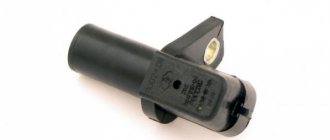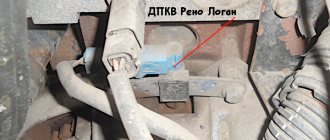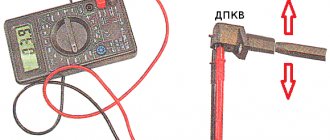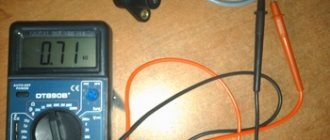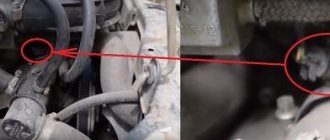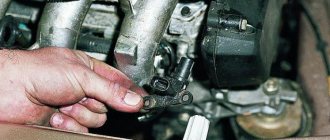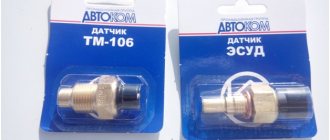The crankshaft position sensor on VAZ 7 series vehicles is designed to synchronize the fuel injection process with the ignition system. Failure of this part leads to unstable engine operation and incomplete combustion, and hence to fuel overflow. The engine does not reach full speed or does not start at all. The article describes the reasons for the malfunction of this unit, its design, testing methods, as well as the process of removal from the engine.
Crankshaft sensor for VAZ 2107
The crankshaft position sensor on VAZ 7 series vehicles is designed to synchronize the fuel injection process with the ignition system. Failure of this part leads to unstable engine operation and incomplete combustion, and hence to fuel overflow. The engine does not reach full speed or does not start at all. The article describes the reasons for the malfunction of this unit, its design, testing methods, as well as the process of removal from the engine.
Purpose
The crankshaft position sensor in the seventh Zhiguli model is used to determine the position of the crankshaft and, accordingly, to determine the position of the piston at top dead center. The sensor is involved in the spark formation process, namely, it determines the moment when and into which cylinder it is necessary to supply a spark and fuel.
DPKV is one of the sensors, without which the car engine will not be able to operate, since the ECU will not be able to determine what position the pistons are in at a given time.
DPKV design
DPKV or crankshaft position sensor on the VAZ-2107 is an inductor with a magnetic core. The part is a plastic or aluminum case, inside of which there is a magnetized core on which a copper wire is wound. The core wire is insulated from the body using PVC insulation or compound resin.
Principle of operation
An inductive type DPKV is installed on fuel-injected VAZ-2107 vehicles. The sensor is located next to the “monitoring” disk. There are teeth along the entire edge of this disk. And only in one place there are no 2 teeth. It is to the position of this gap that the DPKV reacts. With each revolution, a signal is sent to the electronic control unit (ECU), thereby notifying that an empty section of the disk has passed. Next, the ECU sends a signal to the injectors, only after which fuel is injected. In addition to fuel injection, synchronization with the operation of the ECU is carried out. Based on the supplied signal, it is possible to determine:
Location
On the VAZ 2107, the DPKV is located on the cylinder block body; there is a special ebb point for it, in the ear of which it is installed, and the control circuit connector is connected to it. You can see the sensor by looking under the hood; the sensor is located near the crankshaft pulley between the engine and the radiator cooling fan.
Sensor check
In order to make sure that the crankshaft position meter is working properly, it is necessary to check it. On injection VAZ-2107 cars, the crankshaft position sensor is located on the camshaft cover bracket.
There are 3 ways to check.
A quick check can be done using a screwdriver and a multimeter. Connect the probes of the device to the coil terminals. Set the measuring device to the “continuity” position. Place a metal screwdriver in front of the magnetic core. While the screwdriver is in front of the core, the multimeter will show the moment the contacts open.
It is important to remember that before removing the part, you must disconnect the “-” terminal of the battery. Don't forget about setting tags. This will help you easily install the sensor and start the engine.
Removing the sensor
Before checking the crankshaft position sensor or replacing it, you must remove this unit.
To do this you need:
The operation to replace the sensor is carried out in the reverse order.
The crankshaft position sensor on the VAZ-2107 is responsible for the stability of the injection system of the ignition and gas distribution system. These parameters affect the operation of the engine, and therefore the overall dynamics. Timely inspection and replacement of a faulty unit will help to avoid problems with bending of the intake and exhaust valves, fuel overflow and excessive fuel consumption. The engine will gain smoothness in the set of revolutions, their stability and dynamics during acceleration.
Replacing the crankshaft position sensor on a VAZ 2104, VAZ 2105, VAZ 2107
Welcome! Crankshaft position sensor - it monitors where the crankshaft is during operation and in a certain place (When the pistons are at TDC), the sensor sends a signal to the controller, which in turn pours fuel into the engine through the injectors and gives a spark through the spark plugs ignition, thanks to this sensor, all this is done together, that is, first the fuel is poured in and then with the help of a spark it is burned, if this sensor fails (completely means), then you will not start the engine because it will not be able to transmit a signal when the pistons will be at TDC, and therefore there will be no fuel or spark, so the engine will not start.
Note! To replace this sensor, you don’t need many tools, just take one Phillips-head screwdriver, and of course you will need a new sensor itself!
Where is the crankshaft sensor located? In the injection classic, it is installed on the bracket of the camshaft cover (the cover is indicated by a green arrow, and the bracket on which the sensor is located is red), it is directed towards the crankshaft pulley, in the photo below, unfortunately, the pulley has already been removed and you will not be able to see it, but on In your car it will be installed, and the pulley will be installed on the shaft itself (Crankshaft), this shaft is also indicated with a blue arrow.
When should you replace the crankshaft position sensor? Let us repeat once again, the crankshaft sensor is the only sensor in the injection classics; if it fails, the engine will no longer start, so if your “check engine” light comes on and the car does not start, then you can blame this sensor, of course, the first thing you do is check it you will have to remove and then check (we will write about how to perform the check a little later, so as you read the article you will learn how to do this), by the way, even if this sensor comes out (depending on what is broken inside it), the engine can still start, but run it will either not be smooth (the speed will float), or the power will noticeably disappear, and besides, it will most likely stall at low speeds.
What are the differences?
Still, the total mass is the SAME. They may have different names, but the essence remains the same. BUT in some modern cars, instead of a mass air flow sensor (explanations and explanation will be below), DBP + DTV can be installed.
Also, some cars have an improved gas distribution system on which phase shifters are installed; they can be hydraulic or electric, both of which can have control “points”
If you don’t take complex engines, like SKYACTIV from MAZDA, because they also have “ion sensors” and don’t take into account turbocharged engines (there are a few more added), otherwise the similarity is very great.
That is, we will consider ordinary atmospheric engines without phase control systems.
Which is exactly what a large number of simple motors are. Well, let's start and look at each one individually.
How to replace the crankshaft position sensor on a VAZ 2104, VAZ 2105, VAZ 2107?
Note! Before you go to the auto store to purchase this sensor, we recommend that you check the markings on the old one, especially since you can remove it in less than a minute, or even easier, come to the auto store by car (If possible) and remove this sensor from it directly there, after that, show the seller that it is exactly like this, it’s just that each sensor has a core (If you don’t know what a core is, then study the article: “What is DPKV?”) has its own length and if it is not normal (For example, you have a longer install the sensor), then your car will not work correctly, and in general, most likely the end of the core will rest against the teeth of the crankshaft pulley, so the sensor must be exactly the same length as the old one you had, which you removed from the car, please note This!
Removal: Removal is not difficult, as we said earlier, first disconnect the main block of wires from the sensor (see photo 1), this block is secured by a latch, bend it a little and then remove the block (When you remove it, make sure there is no water it didn’t get inside), then use a screwdriver to unscrew the screw that holds the sensor itself (see photo 2) and then, pulling the sensor, remove it from the bracket in which it is installed.
Note! If it is raining outside, for example, and if you are simply afraid that a short circuit may occur if water gets into the inside of the wire block, then in this case, disconnect the minus terminal from the battery and after that you can no longer be afraid of anything, since the system is you will be de-energized, but also try to prevent water from getting into the block! (If you do not know how to disconnect the battery, then study the article in which, in paragraph 1, it is described how to remove the terminal from the battery, this article is called: “Replacing the battery on a VAZ”)
Installation: The sensor is installed in its place in the same way as it was removed, by the way, if you want to check your old sensor for operability, then read a detailed article about this, called: “Checking the DPKV for serviceability.”
Source
VAZ 2107 crankshaft sensor - malfunctions and testing
The crankshaft position sensor of the VAZ-2107 car, as well as other injection vehicles, is designed to synchronize the operation of the engine ignition system, as well as fuel injectors. Failure of this part will lead to one of three situations: unstable engine operation, incomplete combustion of fuel, or complete engine failure.
The most common types of crankshaft sensors are induction. This is exactly the sensor installed on VAZ-2107 injector cars. They have their own characteristics, advantages and disadvantages, as well as diagnostic and repair methods. This information will be briefly presented below.
see also
The article will talk about the VAZ 2107 hall sensor, the advantages of using it, and most importantly, diagnostic and replacement methods. This is an electronic component that is used in the ignition systems of modern cars. Of course, they can be called modern rather conditionally, since Hall effect sensors in the ignition system are used only on carburetor engines. If we are talking about injection systems, then you will find a similar design in them only in revolution and speed sensors, or in alarm systems.
Crankshaft position sensor design
The design of the DPKV is simple and consists of a small number of elements. In particular, its main element is a magnetized steel core on which a thin copper wire is wound. On top they are covered by a plastic (plastic) case. Naturally, in a copper winding, all the wires are insulated from each other (this can be implemented in different ways, for example, through compound resin or conventional insulation made of PVC or other material).
The operating principle of the device is as follows. In the immediate vicinity of the sensor, a “monitoring” disk with teeth around the perimeter rotates. Two of them are missing, creating a kind of emptiness. The main task of the sensor is to record the passage of this section and send appropriate signals to the ECU. If it does this late or with a weak signal, the electronic unit will provide incorrect information to the fuel system, and a mixture of suboptimal composition will be formed.
Crankshaft sensor for VAZ 2107
In any modern car there are many sensors and devices. But only one of them has the ability to turn off the engine. Such a sensor is the crankshaft position sensor.
The crankshaft sensor is located on the camshaft cover bracket. DPKV reports data on the performance and speed of rotation of the crankshaft to the control unit. This data comes in the form of magnetic pulses. Depending on the vehicle assembly, the DPKV may differ.
The crankshaft sensor on a VAZ 2107 with an injector engine consists of a steel core, which is wrapped with copper wire. This design is located in a plastic housing. The wires that are in the sensor are separated from each other by a special polymer insulating resin.
CPPS (crankshaft position sensor) is also called a synchronization sensor. Thanks to it, electronic control works synchronously with the mechanism that provides engine gas distribution and provides a signal for clock, cyclic and angular control of fuel mixture injection and the ignition system. The operating principle of this device is not too complicated and consists in creating inductive signals.
The crankshaft sensor detects the passage of metal pulley teeth near the sensor. The pulley has 60 teeth, two of which are missing. When a gap passes where teeth are missing, this is recorded and allows for order in the operation of the ignition and power systems so that there is a clear distribution of fuel supply through the injectors. Thus, DPKV is an important link, without which stable operation of the car as a whole is impossible.
Design features
To check and replace the sensor, you need to know what it looks like. It wouldn’t hurt to talk a little about its internal structure at the same time. The design of this device is very simple. But it varies somewhat depending on the purpose of the sensor and the installation location. For example, digital ones turn out to be more complicated; they have a semiconductor crystal built into the sensitive part. Between the semiconductor crystal and the small circuit (responsible for switching) there are short sections of connecting conductors.
The semiconductor crystal in the VAZ 2107 Hall sensor must occupy a special position. The magnet is positioned so that its field lines are perpendicular to the plane of the crystal. It is due to this that induction (magnetic) occurs. In this case, some current passes through the crystal. Under the influence of a magnetic field, an electromotive force is generated and supplied to the switching circuit.
Types of sensors
After it has become clear what the crankshaft sensor on the VAZ-2107 and other cars is responsible for, it is worth highlighting the main types of DCPV. At the moment there are several varieties. The table shows modern types of crankshaft position sensors with a description of their operating principle.
| Sensor type | Principle of operation |
| Induction | Its action is based on the use of a magnetized core wrapped in copper wire. The ends of the wire are brought out in order to measure voltage changes. The sensor is mainly used in modern cars. |
| Optic | It works using an LED that emits a beam of light and a receiving device. When a control tooth passes, the beam of light is interrupted, which is recorded by the monitoring device. The collected information is sent to the ECU. |
| Hall Sensor | It works due to a magnet that is installed on the crankshaft and which is fixed. When DC movement begins in the sensor, it is immediately recorded on the synchronizing disk. |
Idle speed control
The idle speed control is only involved in engine operation at idle speed. It is a DC motor with a worm gear on the shaft, which is secured with a cone that blocks the air in the channel of the throttle assembly. U
Installed on the throttle body and secured with two screws.
Signs of malfunction:
- The car stalls;
- Low speed XX;
- Difficult start;
Replacing the sensor
The crankshaft sensor may become unusable and then it needs to be changed. But first, you should pay close attention to the signs of malfunction to be sure that the sensor really needs to be replaced. These signs are:
If the crankshaft sensor on a VAZ 2107 fails, then it must be checked for functionality. To do this, you need to prepare a screwdriver and a multimeter.
Set the position on the multimeter, which corresponds to 200 MV. The outputs from the DCPV must be connected to a multimeter. Bring an object, maybe a screwdriver, in close proximity to the core. Voltage surges should appear on the multimeter. If this does not happen, then the sensor is broken and needs to be replaced.
To install a new crankshaft sensor on a VAZ 2107 with your own hands, you will need:
First of all, it is necessary to de-energize the sensor. To do this, you will need to remove the block with wires from it.
Unscrew the mounting screw with a 10 mm socket wrench and remove the DPKV.
Install a new one in place of the broken sensor.
After installing a new DCPV, you should check the distance between the sensor core and the pulley teeth. It should be within: 1 mm +/- 0.41 mm.
If the numbers are different, this indicates that there is dirt under the device. The sensor may be pushed out or pushed back too far. You cannot reduce the distance, you can only expand it. After installing the sensor, start the engine and check its operation.
Thus, the crankshaft sensor on the VAZ-2107 is a rather important device. If the faults mentioned above occur, first of all you need to check the crankshaft sensor. It does not have a complicated device, and you can check it in the simplest way - measure the resistance of the coil. If there are no diagnostic devices, then you need to contact a professional at a service station.
Source
Signs of breakdown
The car itself can tell you that the DS is out of order. To do this, you just need to pay attention to the characteristic signs of such a breakdown:
- The speedometer does not work at all or provides incorrect information about the current speed;
- Idling behavior is unstable;
- Gasoline consumption is increasing;
- The motor does not produce full power.
The practice of VAZ 2109 owners shows that the most obvious sign of a breakdown of the engine is the engine stopping at idle while coasting, or the engine stopping when the clutch is pressed to change speed.
If the engine breaks down, the “Check Engine” light on the dashboard should light up. If the car is equipped with an on-board computer, then the error code corresponding to the malfunction is 24.
Causes of failure
There are several main reasons why a DS may stop working:
- There is a break in the electrical circuit. Therefore, first of all, we advise you to check the condition of the wiring and contacts. They could become dirty or oxidized. It's not difficult to clean them. Additionally, we recommend treating contacts with Litol.
- Break near the connector. Here the wiring often bends and chafing occurs. Don't forget to check the condition of the insulation of the wires that are located near the exhaust manifold. Often they melt under the influence of temperature, which leads to short circuits.
- The speedometer cable is worn out. Over time, as the vehicle is used, the cable becomes covered with burrs, cracks, and breaks. As a result, the speed sensor stops working properly.
Verification methods
The first thing you need to do is make sure that a voltage of 12 V is supplied to the DS contacts. Since the operation of the DS is based on the Hall effect, the test is performed by torsion. The voltage varies within 0.5-10V.
Today, there are three main ways to check the performance of a speed sensor. The first two involve the use of a multimeter. Which one to choose, decide for yourself. We will talk in detail about all three methods of checking DS.
Verification method
Your actions
If checking the DS shows that everything is fine with it, be sure to check the functionality of the sensor drive. It is necessary to hang up the front wheel and find the DS drive by touch. Now start rotating the wheel with your foot and check with your hand whether there is rotation in the drive and how stable it is. The help of a partner will not hurt you here.
Crankshaft sensor for VAZ 2107 - design and principle of operation
The crankshaft position sensor or DPKV on the VAZ 2107 ensures engine operation (not stable, but overall). With its help, the ECU knows what position the crankshaft is in. From this, the control unit knows the location of the pistons in the cylinders, which directly affects fuel injection through the injectors, and the occurrence of a spark to ignite the fuel assembly.
The device in question has a simple design. The sensors installed on the seven work on the principle of inductance. The part consists of a metal cylindrical base with a wire wound on the surface (coil). The top of the coil is covered with a permanent magnet. The operation of the device is associated with a ring gear, which is attached to the crankshaft. It is with the help of this ring gear that the sensor records signals and transmits them to the computer. The principle of operation of the device is as follows: when the crown tooth is located at a level with the steel core of the DPKV, an electromotive force is induced in the winding. A voltage appears at the ends of the winding, which is detected by the ECU.
The gear wheel consists of 58 teeth. Two teeth on the wheel have been removed to determine the starting position of the crankshaft. If the DPKV fails, which is extremely rare, then starting the engine and its operation is simply impossible. The marking of the sensor, which is installed on the VAZ 2107, is as follows - 2112-3847010-03/04.
Signs of sensor failure
The main sign of a DPKV failure is the impossibility of starting the engine. Such a breakdown occurs due to a complete malfunction of the device. If the surface of the DPKV is dirty or the contacts are oxidized, the following malfunctions can be detected:
If the above symptoms are detected, then DPKV should be checked. To do this, you need to know where the crankshaft sensor is located. On the VAZ 2107, the DPKV is located on the front engine cover, where it is fixed to a bracket. On other car models, this element may be located on the other side of the crankshaft near the flywheel. If you suspect a breakdown of the DPKV, it must be checked.
Methods for checking DPKV
You can check the suitability of the crankshaft sensor on the seven in three different ways. To begin with, it should immediately be noted that the malfunction of the device can be determined visually. To do this, you should inspect the part, and if there is contamination, as well as microcracks on the magnet body, you can judge that it is broken. Contaminants are easily removed, but if there are microcracks, the part must be replaced.
The crankshaft sensor on the VAZ 2107 injector is checked in three ways:
The inductive crankshaft position sensor, which is used on the seven, creates sinusoidal pulses. They arrive at the ECU, where they are rectified into rectangular pulses. Based on these pulses, the control unit makes a decision about sending a pulse to the injectors and spark plugs at the right time. If during the inspection it turns out that the DPKV is faulty, it should be replaced.
How to replace the crankshaft sensor on the seven
Knowing where the DPKV is located on the VAZ 2107, it will not be difficult to dismantle the device. This procedure is not difficult and does not take much time. Detailed instructions on how to replace the crankshaft sensor on a VAZ 2107 look like this:
After replacing the device, you can check the performance of the engine. Despite the fact that the part rarely fails, it is recommended to always have a spare sensor in the car. If an element fails, it can always be quickly replaced to continue moving.
As a result, it should be noted that DPKV is the most important sensor. It has a simple design and rarely fails. The estimated cost of the device for the seven is about 1000 rubles. It is recommended to check the part not only when the first signs of a malfunction appear, but also periodically to clean the working surface from contamination.
Source
Electronic engine control unit
The VAZ 2107 engine control unit is the main element responsible for the proper operation of the entire internal combustion engine. The block processes a huge number of different processes. All sensors that are installed on the “seven” are directly connected to the computer. It is he who reads information from the sensors and sends signals to fuel injection with the required amount of gasoline and fuel concentration. If the ECU breaks down, the car may stop starting or have problems similar to signs of failure of any of the sensors.
The engine block is located under the glove compartment on a special bracket.
